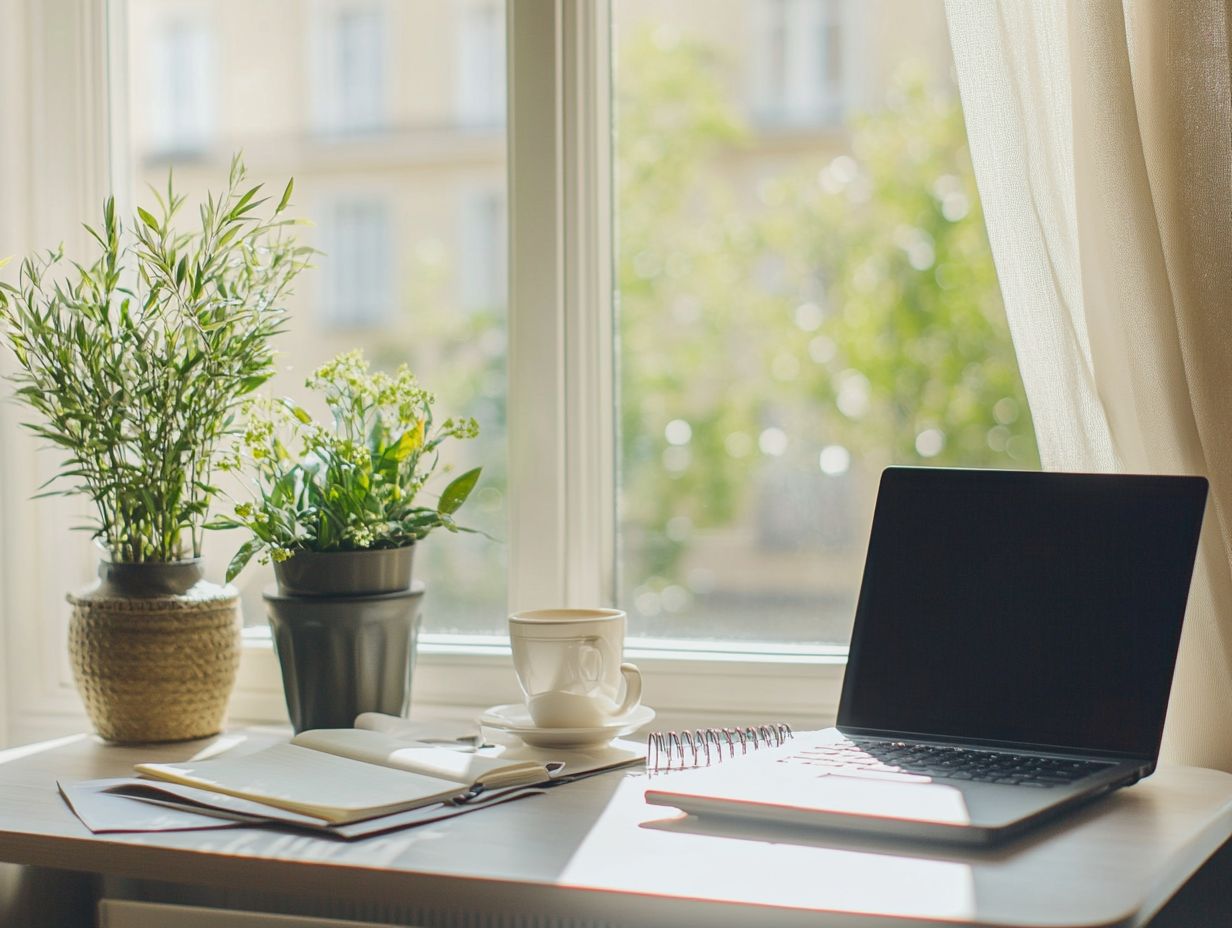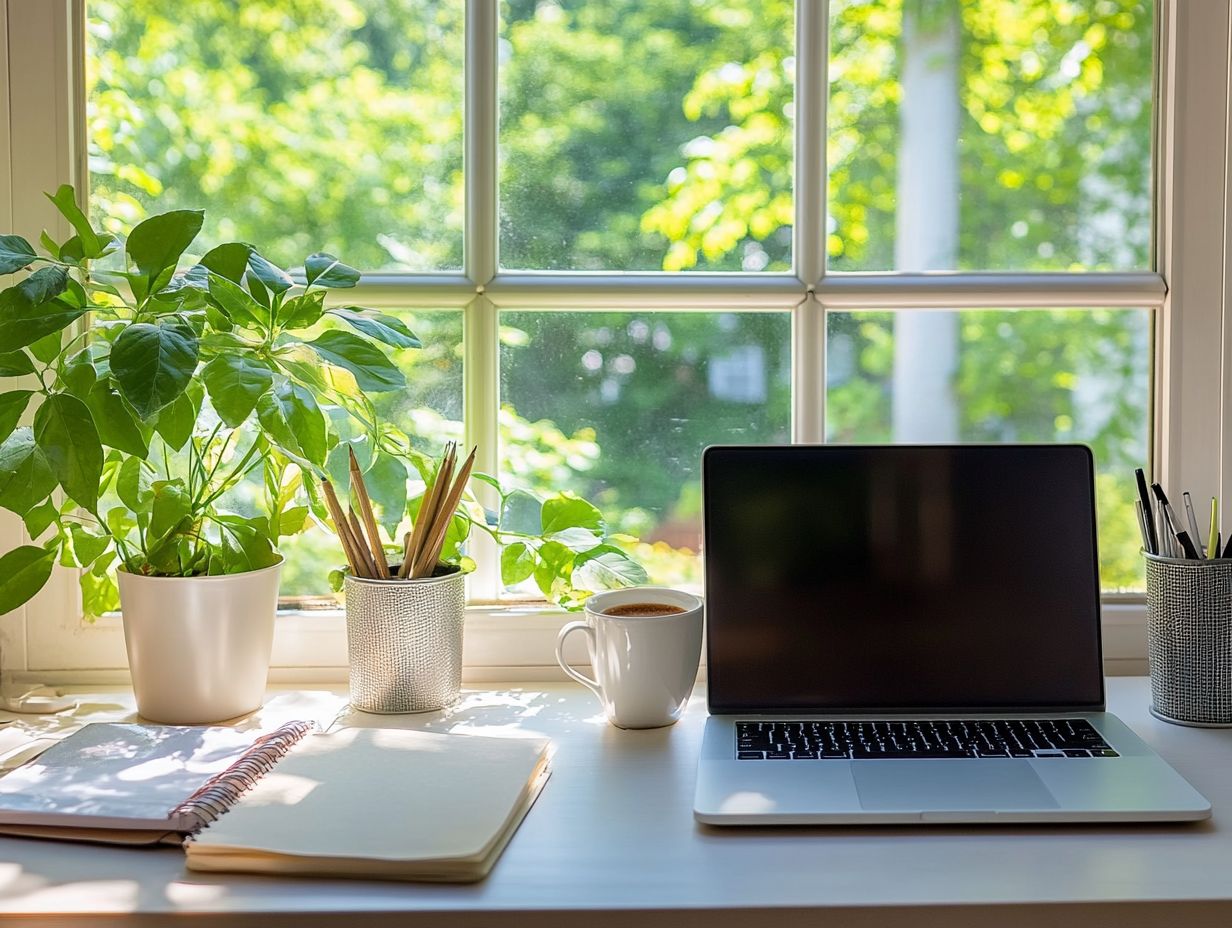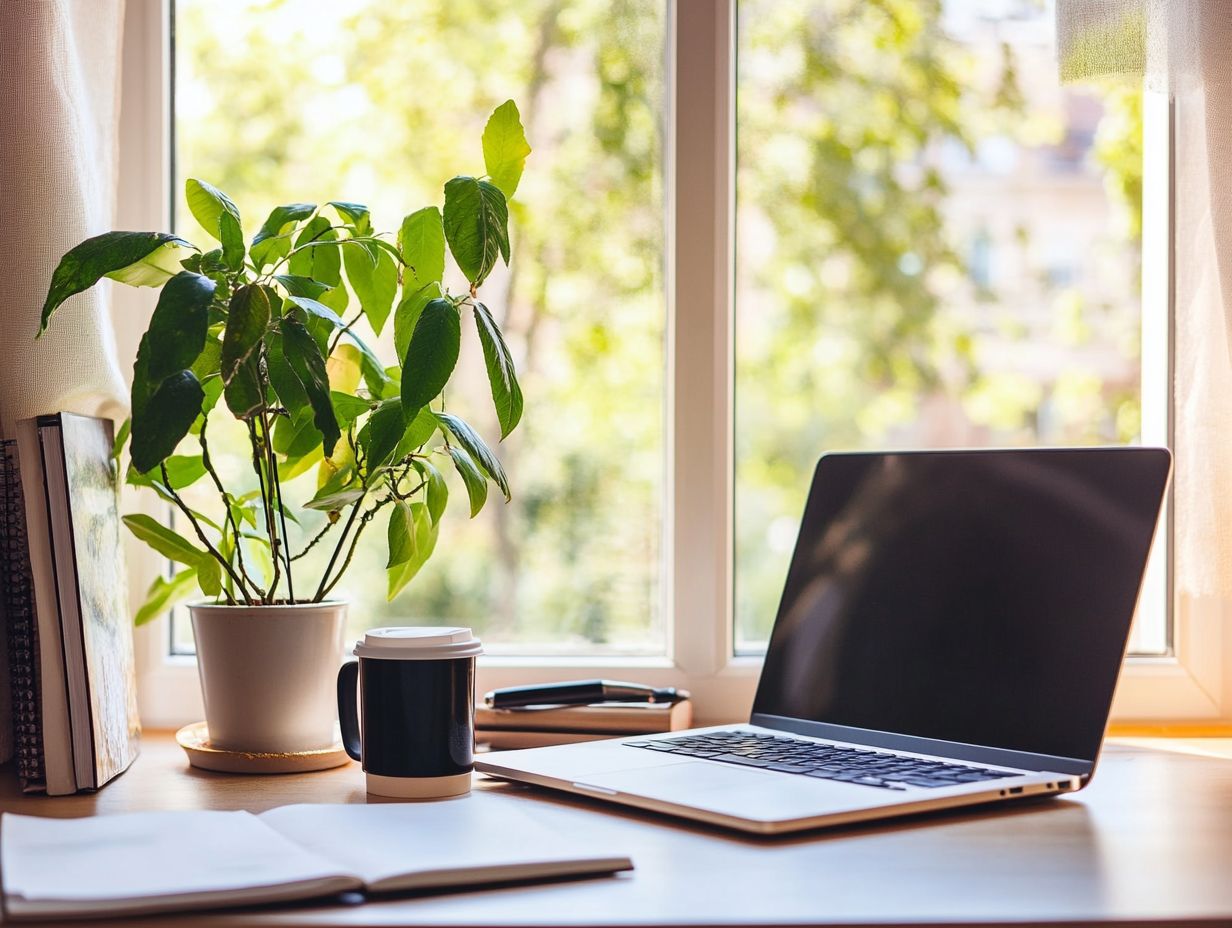Creating a Productive Environment: Key Tips
In today s fast-paced world, understanding the connection between productivity and your surroundings is crucial for achieving success.
This article explores how both physical and psychological factors influence your productivity levels, providing valuable insights on designing environments that promote efficiency.
You will discover strategies for optimizing your space, integrating natural elements, and establishing effective routines and habits to create a truly productive atmosphere.
We will explore how to maintain your productive environment and track your progress, ensuring your journey toward heightened productivity remains rewarding and sustainable.
Contents
- Key Takeaways:
- Understanding Productivity and Environment
- Factors That Affect Productivity
- Designing a Productive Environment
- Establishing Routines and Habits
- Maintaining a Productive Environment
- Measuring and Improving Productivity
- Frequently Asked Questions
- 1. Want to boost productivity? Here are key tips to create a productive environment!
- 2. How can decluttering help create a more productive environment?
- 3. Why is setting clear goals and priorities important for productivity?
- 4. How can I minimize distractions in my workspace?
- 5. How do natural light and plants improve productivity?
- 6. Is it important to take breaks in a productive environment?
Key Takeaways:

- Understanding the relationship between productivity and environment is vital for creating a successful workspace.
- Both physical and psychological factors significantly affect productivity; considering both is essential for a productive environment.
- Consistency, adaptability, and goal-setting are crucial for maintaining a productive environment; small changes can lead to substantial improvements.
Understanding Productivity and Environment
Understanding productivity and its relationship with the environment is essential, especially in the wake of COVID-19. The pandemic changed how we view remote work and altered our work-from-home practices.
In this evolving landscape, your productivity relies not just on your work habits and motivation but also on the physical and psychological elements of your workspace. Cultivating the right environment, such as creating a productive home office setup, can significantly enhance your productivity and mental well-being, fostering a positive company culture that encourages effective communication and collaboration.
Defining Productivity and Its Relationship with Environment
Productivity is the measure of how effectively you complete your work, heavily influenced by the environment in which it takes place especially in remote work scenarios.
This efficiency isn t solely about personal effort; it s intricately linked to various environmental factors. For instance, imagine stepping into a well-designed workspace that promotes focus and organization, as opposed to dealing with poor lighting that leads to fatigue and distractions. The temperature of your room can either invigorate your spirit or drain your energy, significantly affecting your concentration and output.
Noise levels also play a critical role in your productivity journey. Excessive background noise can disrupt your thought processes, while a harmonious ambiance can spark creativity. Understanding these factors is essential for remote workers, as cultivating an optimal environment sustains productivity amid the comforts and distractions of home.
Factors That Affect Productivity
Numerous factors significantly influence productivity levels among employees, encompassing both physical and psychological elements.
By implementing the right workplace strategies and leveraging technology, you can enhance these aspects and foster a more productive environment.
Physical and Psychological Factors
Both physical and psychological factors are crucial in shaping your productivity levels. Elements like ergonomics designing your workspace for comfort and workspace design can significantly impact your efficiency.
Consider this: a well-organized workspace with suitable seating can drastically reduce discomfort, allowing you to maintain focus for extended periods. Companies that invest in high-quality office chairs and adjustable desks often see a reduction in ergonomic complaints, leading to greater employee satisfaction.
A well-structured technology setup can also minimize frustration. When your devices are up-to-date and easily accessible, it fosters a smoother workflow. On the psychological front, addressing workplace stress through open communication and fostering a supportive culture enhances mental well-being.
Organizations that conduct regular check-ins and implement wellness programs typically experience a boost in employee engagement and morale. This highlights the powerful interplay between physical environment and psychological health in the workplace.
Designing a Productive Environment

Designing a productive environment requires thoughtful consideration of several key elements. Pay attention to the space layout, quality of lighting, and inclusion of natural elements. For more insights, check out how to set up a productive workspace. Cultivating an atmosphere that nurtures both creativity and efficiency allows you to thrive in your work.
Optimizing Space and Layout
Optimizing the space and layout in your workspace is crucial for elevating productivity. It directly impacts how employees move, interact, and feel comfortable.
Consider how different layout configurations like open spaces versus traditional cubicles can influence collaboration opportunities and individual task efficiency. An open layout invites spontaneous interactions and teamwork, fostering a culture rich in communication and idea-sharing. In contrast, cubicles provide a sense of privacy, allowing individuals to concentrate on their tasks without distractions.
Integrating the right technology, such as smart whiteboards, video conferencing tools, and mobile workstations, enhances these layouts further. Seamless communication and access to essential resources create an ideal configuration that boosts engagement and elevates overall productivity.
Incorporating Natural Elements
Incorporating natural elements into your workspace design can significantly boost productivity, creating a pleasant and stimulating environment.
Ample natural light flowing in makes your workplace feel open and inviting, enhancing focus and sparking creativity. Integrating plants not only adds a refreshing touch of greenery but also purifies the air, promoting a healthier indoor climate. The use of natural materials, such as wood and stone, adds warmth that helps alleviate stress levels.
To implement these elements effectively, consider:
- Positioning desks near windows
- Using design that incorporates nature
- Selecting indoor-friendly plant species
This exciting combination boosts mood and creates a thriving workspace while nurturing a stronger sense of community among colleagues.
Establishing Routines and Habits
Establishing effective routines and habits is essential for enhancing productivity, particularly in a remote work environment. You must skillfully balance work and life while maintaining focus amid distractions.
Creating a Daily Routine
A well-crafted daily routine is your secret weapon for boosting productivity and achieving a harmonious work-life balance. It provides the structure and consistency often elusive in a flexible remote work environment.
Setting clear boundaries around your work hours cultivates a focused atmosphere that minimizes distractions. This approach carves out time for nutritious meals, keeping your energy levels high throughout the day. Scheduled breaks are just as crucial; they give your mind a chance to recharge and spark creativity.
However, rigidity can kill productivity. Incorporating a bit of flexibility into your routine allows you to make adjustments based on your personal work habits and the daily ebb and flow of life. This adaptability enhances your well-being and deepens your engagement with tasks.
Developing Productive Habits

To maximize your productivity, developing effective habits is key! These habits create a solid framework for accountability and foster continuous improvement in your work environment.
Incorporating specific practices, such as regular feedback sessions, allows you to gain valuable insights that sharpen your focus and streamline your efforts. An organized workspace is equally crucial; it minimizes distractions and nurtures a mindset that encourages creative thinking.
Setting personal goals enables you to track your progress and keeps you motivated. Take a moment to reflect on your current habits are there routines that could be fine-tuned or replaced?
Identifying these areas for improvement can lead to significant enhancements in your overall productivity.
Maintaining a Productive Environment
Maintaining a productive environment demands both consistency and adaptability. You want to create a space where employees can truly thrive, especially in a remote setup shaped by the impacts of COVID-19. Incorporating tips for creating a goal-focused environment can further enhance this dynamic.
This balance fosters an atmosphere of growth and resilience.
Tips for Consistency and Adaptability
To achieve consistency and adaptability in a productive environment, focus on establishing clear communication channels and fostering regular feedback among employees. This approach addresses workplace stress and cultivates a supportive atmosphere.
Creating a space where team members feel valued and heard is essential; it can significantly enhance morale and engagement.
By implementing technology tools like project management software and communication platforms, you can streamline interactions and ensure that everyone remains aligned.
Promoting flexible work arrangements, such as remote options or adjustable hours, acknowledges individual needs and boosts overall satisfaction. By prioritizing these practices, you can help cultivate a work environment where productivity flourishes, paving the way for both individual and collective success.
Measuring and Improving Productivity
Measuring and enhancing productivity is essential for any organization aiming to ensure that employees meet expectations. This process involves conducting regular assessments and actively gathering feedback to pinpoint areas ripe for growth.
Start assessing productivity today to unlock your team s full potential! By fostering a culture of continuous improvement, you enable your team to thrive and achieve their full potential.
Assessing and Setting Goals
Assessing and setting goals is essential for measuring productivity. This allows you to align your efforts with strategic objectives while fostering a sense of accountability and engagement.
By implementing the SMART criteria Specific, Measurable, Achievable, Relevant, and Time-bound you can elevate your goal-setting framework, ensuring that each target is clear and reachable. This clarity helps you understand how your individual contributions fit into the overall goals, ultimately boosting your motivation and sense of ownership over your work.
Regular assessments are crucial in this process, enabling you and your team to track progress and make necessary adjustments. Cultivating a culture of feedback supports continuous improvement and encourages open communication, reinforcing a collaborative environment where you feel valued and integral to the organization’s success.
Implementing Changes for Improvement

Implementing changes to enhance productivity requires an active approach. Actively seek feedback from employees to pinpoint challenges and opportunities within the workplace.
By fostering a culture of open communication, you can ensure that your team feels valued and heard. This leads to smoothly implementing the changes that matter most! This might involve regular surveys or suggestion boxes, where team members can share their insights and experiences.
For example, a tech company recently revamped its project management processes after gathering input from its staff. This led to a remarkable 30% increase in project delivery speed and significantly boosted overall morale.
Engaging employees in workshops dedicated to brainstorming solutions not only empowers them but also helps identify the root causes of productivity issues, paving the way for more knowledge-based decision-making.
Frequently Asked Questions
1. Want to boost productivity? Here are key tips to create a productive environment!
Some key tips include decluttering your space, setting clear goals and priorities, minimizing distractions, and incorporating natural light and plants into your workspace.
2. How can decluttering help create a more productive environment?
Decluttering your space can reduce visual distractions and enhance focus and organization. It can also foster a sense of calm and clarity, making it easier to stay on task.
3. Why is setting clear goals and priorities important for productivity?
Setting clear goals and priorities helps you stay focused and motivated, providing a clear direction for your work. This aids in managing time effectively and making better decisions about where to allocate your energy.
4. How can I minimize distractions in my workspace?
You can minimize distractions by turning off notifications on your devices, using noise-cancelling headphones, and setting boundaries with coworkers or family members. Having a designated workspace where you can shut the door or use a “do not disturb” sign can be very helpful.
5. How do natural light and plants improve productivity?
Natural light and plants positively impact mood, energy, and concentration. By incorporating these elements into your workspace, you create a pleasant and healthy environment that can boost productivity.
6. Is it important to take breaks in a productive environment?
Yes, taking breaks is essential. It is recommended to take short breaks every 60-90 minutes to recharge your brain. This can improve focus and prevent burnout, ultimately leading to increased productivity.






